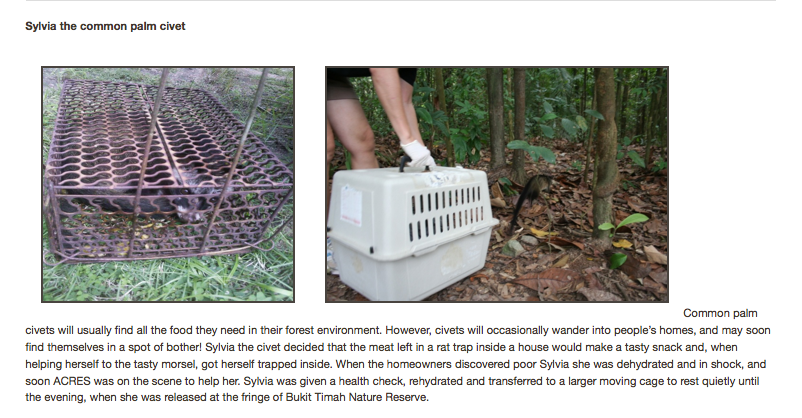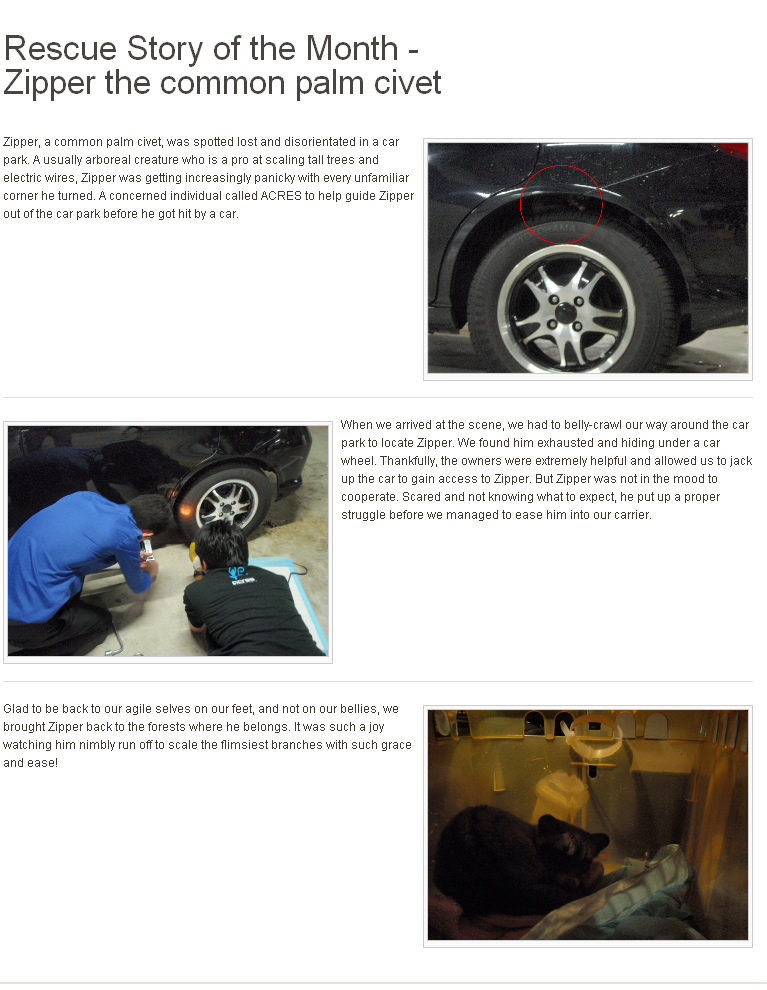This article was published in Lian He Wan Bao on the 20th of May, 2015. We have included a translation below, and are at the same time relieved that the civet managed to be returned back to the forest safely. Thank you so much ACRES, especially Anbu and Kalai (the wildlife rescue team on duty that day) for always being so enthusiastic and passionate about your work. Thank you for keeping our native civets safe too.
CIVET CAPTURED AFTER A HALFHOUR STRUGGLE
Reported by Daryl Lim for Lianhe Wanbao, 20th May 2015
A common palm civet was trapped in a house in Queenstown for two hours, unable to descend after having climbed up the sewage pipes. The Animal Concerns Research and Education Society (ACRES) rushed to the scene upon receiving the news, and thus began a relentless half-an-hour chase for the civet until it was finally forced into a dead corner and trapped in a cage.
The civet – which caused a great deal of chaos in the neighbourhood – appeared on 55 Strathmore Avenue at approximately 9.45 p.m. yesterday night. Resident Huang Zhen Shun (80 years old) then called and notified Lianhe Wanbao after witnessing the civet’s appearance.
Huang Zhen Shun said that he was speaking with a group of friends on the ground floor of the house when he saw a dark shadow dash across the road suddenly, right before their eyes. He said, “Its movements are extremely fast, and we quickly followed to check what it was. We didn’t expect that it turned out to be a common palm civet. We didn’t chase it for long before it climbed up the sewage pipes.”
Upon arriving at the scene, the reporter found the civet sitting on the sewage pipe that was 3 metres high. Furthermore, it looked relaxed with its long tail dangling midair.
The civet is believed to be an adult one, measuring at about 2 metres in length inclusive of its tail.
Huang Zhen Shun said that the civet stayed on the sewage pipe for nearly 2 hours after climbing up, refusing to come down. It looked timid and did not seem like it was aggressive. “I suspect that it was illegally kept as a pet by someone, but had managed to escape successfully.”
After arriving at the scene, 2 staff members from ACRES first climbed up an aluminium ladder, hoping to carry the civet down. They also tried to lead it to jump into an already setup trap, but the civet was extremely quick and intelligent and managed to avoid it. Eventually it managed to jump back onto the floor and ran towards the house’s walkway.
The staff members pursued, and finally managed to force the civet into a dead corner.
Having no other possible escape route, the civet began to resist capture and tried to put up a fight, struggling against the ACRES staff members for nearly half-an-hour before it was finally caught and kept in a cage.
The civet will be returned to the forest after capture.
Civets are not uncommon in Singapore, and are neither threatening nor aggressive towards humans. Wild civets found to have trespassed onto human property will be released into the forest after being caught. After news of the civet’s appearance spread, countless residents came forward to observe the scene. Some even took photos as a form of keepsake memento. Some older residents commented that they have not come across wild civets since after leaving the kampungs. Louis Ng, the director of ACRES, expressed that civets are nocturnal animals that live in the forest and feed on fruits and insects. They will not deliberately cause any harm to nor threaten the safety of people. “Should the public come across a civet, do not panic, and also do not use flashlights on them. After being rescued by ACRES, the civets will be released back into the forest.”



